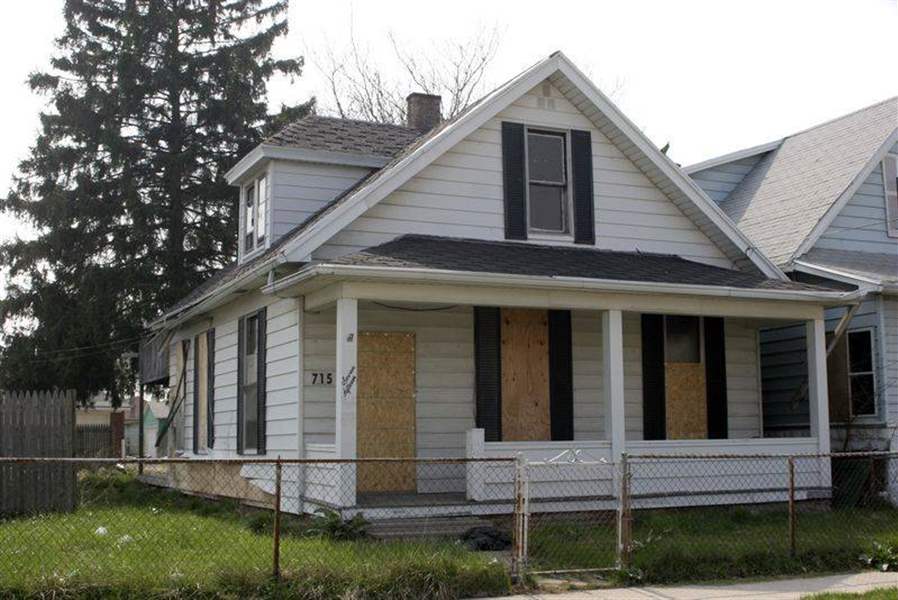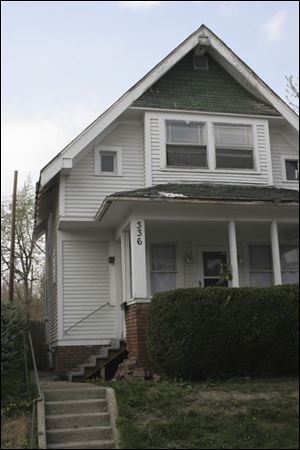
The housing boom's distressed flip side
4/24/2005
This house on Chicago Street in Toledo's near north side sold for 15 percent of Lucas County's estimate of its worth.

This house on Chicago Street in Toledo's near north side sold for 15 percent of Lucas County's estimate of its worth.
THE WINDOWS are boarded up, but the bungalow on Chicago Street in Toledo's near north side otherwise appears salvageable. Yet last summer, it sold for $3,000, or 15 percent of Lucas County's estimate of its worth.
It was one of about 600 residential properties in the county that sold last year for $10,000 or less, according to auditor's office records.
Such properties, which represented 5 percent of sales in the county in 2004, reflect the other side of the area's mortgage-rate-driven housing boom: distressed houses and lots that sometimes fetch less than the stainless steel refrigerators installed in the new houses of the area's sprawling suburbs.
"Occasionally, these houses are habitable," said real estate agent Julia Bryant. "Most of the time, they need something. And the average person isn't equipped to discern what they need. Usually, they're bought by investors."
Ms. Bryant, of Coldwell Banker Flex Realty, specializes in central city properties.

A two-story, 1,200-square-foot house on Mentor Street near Toledo's Old West End brought $6,000 last May.
A list of sales of $10,000 and less provided to The Blade is 212 pages. The newspaper excluded sales involving token amounts under $50 and multiple-property transactions showing no payment for individual parcels.
Of the remaining transactions, 5 percent were outside Toledo in communities including Holland, Oregon, Curtice, Sylvania, and Maumee.
One transaction, for $6,000, was on prestigious River Road in Maumee. The buyers couldn't be reached, but a check of county real estate records indicate the sale involved a small vacant lot.
Another that was equally eye-popping was a $500 pur-
chase on Arcadia Street in central Toledo by Jesse and Gayle Graham.
It involved a lot that became vacant when the house burned, explained Mr. Graham, who lives across from the property. "I bought it to clean it up and make it look nice," explained the buyer, who has resided in the neighborhood more than 30 years.
But some of the sales are of spacious houses that appear to be occupied.
A two-story house on Mentor Street, off Cherry Street near its intersection with Collingwood Boulevard, fetched $6,000 last May. The 1,200-square-foot house, which was built in 1917, has three bedrooms, according to county records. The buyer couldn't be reached for comment.
The house on Chicago Street sold for $25,000 six years ago, county real estate records show.
It was purchased in July from a bank by a Las Vegas firm that specializes in online home liquidations. Bill Iverson, of Iverson Investments Inc., said the property has been sold again, but the buyer failed to record the deed. He didn't disclose the price.
Some streets had multiple sales under $10,000. Records showed at least six such sales on Belmont Avenue and at least five on Pinewood Avenue. And there were numerous such sales in the old north end, near south side, and central city.
Although the sales can be a nice deal for an investor or individual buyer capable of repairs, they aren't necessarily good news to the nonprofit community development agencies that are attempting to improve central city neighborhoods' housing stock.
Often, houses are snapped up by investors looking to make a quick buck.
Low selling prices tend to depress already low housing values, said Deborah Younger, executive director of Onyx Inc. If an individual or investor does a good job on rehab, the houses can boost values.
But that often doesn't happen because repairs turn out to be more daunting or costly than the buyers expected. Repairs by investors are sometimes shabby and short-lived, she said.
Onyx has built 150 houses in Toledo's central city over the past eight years. However, it is able to sell for $105,000 to $110,000 a house that cost $160,000 to build. The organization must make up the difference through fund-raising.
Still, Onyx's director insisted that sales under $10,000 in her service area are rare. "Most of the people in our community have been in these houses a long time and are holding on to them."
Meanwhile, Lucas County records show that even in Toledo's least expensive real estate market neighborhood, the median house price was $24,000 in 2004.
That's less than a quarter of the county-wide average of $110,000, but far above $10,000.
Another neighborhood booster questions whether a majority of the low-ball sales reflect normal transactions.
"They can often be from one family member to another," said Terry Glazer, executive director of the nonprofit Lagrange Development Corp. "Some investors want to avoid responsibility for repairs. So they arrange a transfer to a friend or another company they're involved in."
When sales are legitimate, "these are homes that are in poor shape, that have been minimally maintained, or abandoned."
In the Lagrange Street neighborhood in North Toledo, rehabilitated homes sell for $50,000 or more, he added.
A two-bedroom house on Orchard Street in the near south side sold last August for $4,000. Like many such properties, it was involved in a foreclosure action.
The nonprofit Neighborhood Housing Services of Toledo and Viva South bought the house from lender Rock Financial and expect to invest $53,000 in repairs and remodeling. The two organizations will try to find a low to moderate-income buyer.
At the time of sale, the front door and electric meter were missing and the basement was flooded, said Bill Farnsel, executive director of Neighborhood Housing Services.
"It was not habitable. It was more or less a cave above ground."
He added: "There aren't a lot of houses on the market for under $10,000. Sales at that price are often private transactions between investors. The ones we encounter are not habitable."
Contact Gary Pakulski at:
gpakulski@theblade.com
or 419-724-6082.